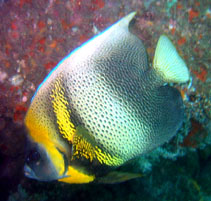| Family: |
Pomacanthidae (Angelfishes) |
| Max. size: |
46 cm TL (male/unsexed) |
| Environment: |
reef-associated; marine; depth range 6 - 12 m, non-migratory |
| Distribution: |
Eastern Pacific: Gulf of California (Puerto Peñasco) and north of Bahía Magdalena (Bahía San Juanico), Mexico to Peru. |
| Diagnosis: |
|
| Biology: |
A diurnal feeder or substrate feeder. Primary food item are sponges supplemented by tunicates, algae, bryozoans, hydroids and eggs. Adults often range widely over the reef in pairs or loose aggregations while juveniles are territorial and solitary. Oviparous (Ref. 240), monogamous (Ref. 52884). Breeding occurs from midsummer to early fall and juveniles are most abundant from August through November. |
| IUCN Red List Status: |
Least Concern (LC); Date assessed: 08 October 2009 Ref. (130435)
|
| Threat to humans: |
harmless |
Source and more info: www.fishbase.org. For personal, classroom, and other internal use only. Not for publication.
